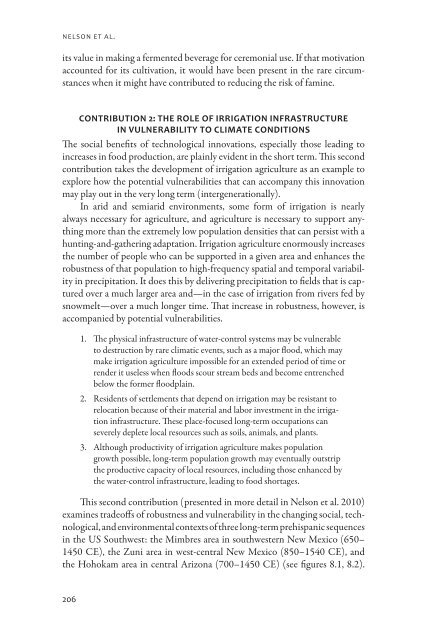free download - University Press of Colorado
free download - University Press of Colorado
free download - University Press of Colorado
You also want an ePaper? Increase the reach of your titles
YUMPU automatically turns print PDFs into web optimized ePapers that Google loves.
Nelson et al.<br />
its value in making a fermented beverage for ceremonial use. If that motivation<br />
accounted for its cultivation, it would have been present in the rare circumstances<br />
when it might have contributed to reducing the risk <strong>of</strong> famine.<br />
Contribution 2: The Role <strong>of</strong> Irrigation Infrastructure<br />
in Vulnerability to Climate Conditions<br />
The social benefits <strong>of</strong> technological innovations, especially those leading to<br />
increases in food production, are plainly evident in the short term. This second<br />
contribution takes the development <strong>of</strong> irrigation agriculture as an example to<br />
explore how the potential vulnerabilities that can accompany this innovation<br />
may play out in the very long term (intergenerationally).<br />
In arid and semiarid environments, some form <strong>of</strong> irrigation is nearly<br />
always necessary for agriculture, and agriculture is necessary to support anything<br />
more than the extremely low population densities that can persist with a<br />
hunting-and-gathering adaptation. Irrigation agriculture enormously increases<br />
the number <strong>of</strong> people who can be supported in a given area and enhances the<br />
robustness <strong>of</strong> that population to high-frequency spatial and temporal variability<br />
in precipitation. It does this by delivering precipitation to fields that is captured<br />
over a much larger area and—in the case <strong>of</strong> irrigation from rivers fed by<br />
snowmelt—over a much longer time. That increase in robustness, however, is<br />
accompanied by potential vulnerabilities.<br />
1. The physical infrastructure <strong>of</strong> water-control systems may be vulnerable<br />
to destruction by rare climatic events, such as a major flood, which may<br />
make irrigation agriculture impossible for an extended period <strong>of</strong> time or<br />
render it useless when floods scour stream beds and become entrenched<br />
below the former floodplain.<br />
2. Residents <strong>of</strong> settlements that depend on irrigation may be resistant to<br />
relocation because <strong>of</strong> their material and labor investment in the irrigation<br />
infrastructure. These place-focused long-term occupations can<br />
severely deplete local resources such as soils, animals, and plants.<br />
3. Although productivity <strong>of</strong> irrigation agriculture makes population<br />
growth possible, long-term population growth may eventually outstrip<br />
the productive capacity <strong>of</strong> local resources, including those enhanced by<br />
the water-control infrastructure, leading to food shortages.<br />
This second contribution (presented in more detail in Nelson et al. 2010)<br />
examines trade<strong>of</strong>fs <strong>of</strong> robustness and vulnerability in the changing social, technological,<br />
and environmental contexts <strong>of</strong> three long-term prehispanic sequences<br />
in the US Southwest: the Mimbres area in southwestern New Mexico (650–<br />
1450 CE), the Zuni area in west-central New Mexico (850–1540 CE), and<br />
the Hohokam area in central Arizona (700–1450 CE) (see figures 8.1, 8.2).<br />
206





